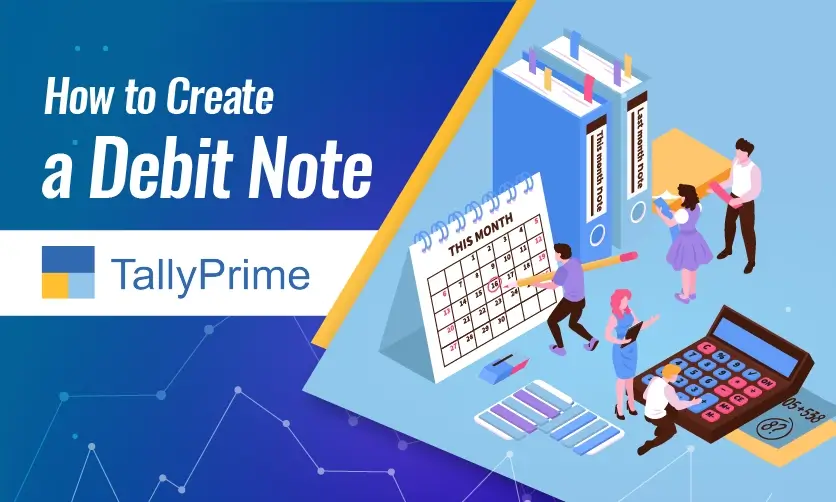
How to Create a Debit Note in Tally Prime
In the complex world of accountancy, maintaining accurate financial data sometimes seems complex even for professionals, especially, when it comes to debt. Thus, to resolve your debt accounting solution easily, the concept of debit note in Tally Prime is introduced.
If you are confused with the term debit note and why it is important in today’s accounting world, then don’t worry.
Yes, we are here with one more interesting article debit note entry in tally prime. The article will describe the Debit Notes in Tally Prime, their specific use case in purchase returns, and more.
Let’s start the discussion first by understanding why businesses generate the debit note.
Table of Contents
Why Debit Notes?
Let us consider that you bought some products, and after purchasing them, when you received the product, you noticed that something was wrong with it. The possible fault in the product may be that it is damaged, defective, or simply not what you ordered. Whatever the case is, you have already paid the amount to the supplier. Now, here debit notes come into play.
A debit note or a debit voucher acts as an official document that a buyer issues to a supplier, mentioning the due amount of the received goods. In simple terms, a debit note tells or informs suppliers that, they have to pay the amount of goods to the buyer due to discrepancies in the original purchase transaction.
Businesses that use Tally Prime to manage accounting work can easily create debit notes in Tally Prime. In the latter, we will explain how a debit note in Tally Prime is created. But before that, clear up your basic concept of debit note tally prime.
What is a Debit Note?
A debit note is defined as a communication tool between the buyer and supplier. In simpler terms, it is a communication tool used by buyers to adjust the value of a previously recorded purchase for specific reasons.
It serves as a formal record and notification to the seller, requesting an adjustment to their invoice, thereby impacting the buyer’s accounts payable and the seller’s accounts receivable.
Focus: Debit Note for Purchase Returns in Tally Prime
When buyers purchase any goods and discrepancies arise, then giving clear and concise information to the supplier about defective items, becomes mandatory. This is the case of debit notes in purchase returns, which means the buyer generates the debit note after purchasing goods.
In such scenarios, debit notes become vital for buyers to generate, and you can utilize Tally Prime software for their creation.
If you are looking to learn more about Tally Prime, then visit these articles:
Let’s first understand the purpose of creating a debit note tally prime.
Understanding the Purpose
When a buyer issues a debit note to a supplier, then the main motive behind this is described below:
- Formal Communication: The first primary reason is to inform the supplier about the discrepancy in the received goods. In addition to that, the buyer will share the complete details of the goods, like the quantity, the reason for return, and lastly, the adjustments in the final payable amount.|
- Accounts Adjustment: The most important thing is adjusting your accounts payable data. This will ensure that your financial data is updated with the revised purchase value.
The next section of the article will describe how a debit note in Tally Prime is generated by a buyer step-by-step.
For a clear understanding, let’s explore debit note tally prime with a real-life case scenario. This will help you to understand how the buyer creates the debit note in Tally Prime practically.
Real-Life Case Scenario: Debit Note in Tally Prime
Scenario:
Let us consider that Mahesh owns a medical shop. He ordered Amoxicillin 500mg of medicine from his regular pharmaceutical distributor (supplier). Upon receiving the medicine, Mahesh found that the 10 boxes of ordered medicine had expired.
Mahesh found this discrepancy and immediately initiated the action of creating a Debit Note in Tally Prime for returning the medicine. As Mahesh knows, the debit note entry is in tally prime, so there is no problem for him to resolve the issue.
But he wants to explain the process of debit notes in Tally Prime to all his staff so that anyone can do this during his absence in the future. Let’s see the step-by-step process of generating a debit note entry in Tally Prime that Mahesh explained to his staff.
Addressing the Issue: Debit Note in Tally Prime Creation
Here are all the steps mentioned that Mahesh will use to create debit notes in Tally Prime to inform the distributor and adjust his accounts:
#1 Accessing Debit Note Feature
In the very first step, Mahesh will explain how to get started with debit note entry in Tally Prime:
- Press Alt+G to open the “Go To” menu.
- Select “Create Voucher.”
- Press F10 to access “Other Vouchers.”
- Type or select “Debit Note” and press Enter.
Alternatively,
- Launch Tally Prime and navigate to the “Gateway of Tally”.
- Go to “Vouchers.”
- Press F10 to open “Other Vouchers.”
- Type or select “Debit Note” and press Enter.

#2 Specifying the Distributor
In the second step, Where Mahesh explains to his staff about entering the details of the supplier in the debit note tally prime.:
- Enter the details of your pharmaceutical distributor.
#3. Linking to the Original Invoice
This step will help Mahesh, to link the original invoice, that he received while collecting medicines:
- In the “Ref” field, present in the dashboard, add the original invoice number for the purchased medicine.
- There is one optional field; you can also enter the original invoice date in the designated field.

#4. Item Details for Expired Medication
Mahesh is explaining to his staff where they can enter the details of the discrepancy. Let’s check out the below steps to understand this step of debit note entry in Tally Prime.
- In the “Stock Items Allocations” section, you need to select “Amoxicillin 500mg” from your pharmacy’s inventory list.
- Add the total quantity of medicine you want to return, here, it is 10 boxes.
- Enter the price per box as per the original invoice.
I hope you are learning the key concepts of debit note tally prime, but if you are interested in learning complete tally, then visit the courses here:

#5. Reason for Return
This step is important for Mahesh as it explains to the distributor Why Mahesh is returning the goods:
- In this “Narration” section, Mahesh has to explain why he is returning the received medicines. For example, Mahesh will write, “Medicine is expired.” This is just an example; you can explain in your own words the reason for the return.
#6. Saving and Printing
In this section of the dashboard for debit note entry in Tally Prime, Mahesh has to complete these two tasks:
- Review the complete details carefully and then save the debit note entry in Tally Prime.
- Mahesh will print a copy of the debit note entry in Tally Prime. This printed copy will be sent to the pharmaceutical distributor. This documentation represents the formal notification regarding the return and processing of a refund.
#7 Impact on Accounts
The most important part of debit notes in tally prime creation is to monitor the change in accounts.
- Mahesh after issuing a debit note, can reduce his accounts payable to the distributor by the cost of the expired medications.
- In the next step, the distributor role comes into play. This means the distributor, after receiving, the debit note and the returned medicines, can issue a credit note. This credit note will inform the client that the returned item has been accepted, and a refund has been initiated. Accordingly, Mahesh will adjust his records.

With this example of expired medicine, we have tried to explain how a debit note in Tally Prime works. It maintains clear formal communication with the supplier and accurate financial records.
Explore more articles on Tally Prime here:
Benefits of Using Debit Notes for Purchase Returns
- Clear Communication: Debit notes offer clear communication with the supplier, which ensures transparency and boosts vendor relationships.
- Accurate Records: By using debit notes, your accounts payable will show the correct outstanding amount after the return.
- Improved Efficiency: Tally Prime streamlines the debit note creation process, saving time and effort.
Learn more about Tally Prime here:
Conclusion
Every business deals with the problem of expired goods, incorrect orders, or damaged items. Whatever the issue, debit notes in Tally Prime solve all these purchase return issues easily.
You can utilize debit note entries in Tally Prime to maintain a smooth workflow and a transparent relationship with the supplier. The tools help you manage clear and up-to-date financial records that give a boost to your business.
- Purchase Order in Tally Prime: Manage Inventory & Expenses - June 7, 2024
- Payroll in Tally Prime: Process, Flow Chart, Features - April 26, 2024
- How to Create a Debit Note in Tally Prime - March 22, 2024

.jpg)






















